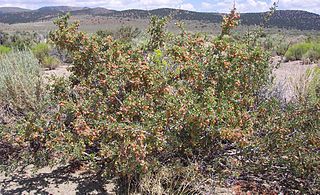
Prunus andersonii is a species of shrub in the rose family, part of the same genus as the peach, cherry, and almond. Its common names include desert peach and desert almond. It is native to eastern California and western Nevada, where it grows in forests and scrub in desert and mountains. It was named after Charles Lewis Anderson by Asa Gray.

Prunus × yedoensis is a hybrid cherry tree between Prunus speciosa as father plant and Prunus pendula f. ascendens as mother. It is a hybrid born in Japan and one of its cultivars, Prunus × yedoensis 'Somei-yoshino' or Yoshino cherry, is one of the most popular and widely planted cherry cultivars in temperate regions around the world today. 'Somei-yoshino' is a clone from a single tree, and has been propagated by grafting all over the world. 'Somei-yoshino' inherits Edo higan's quality of blooming before the leaves unfold and it growing into a large-sized tree. It also inherits the characteristics of the Oshima cherry, which grows rapidly and has white flowers. These characteristics are favored and have become one of the most popular cultivars of cherry trees.

Prunus americana, commonly called the American plum, wild plum, or Marshall's large yellow sweet plum, is a species of Prunus native to North America from Saskatchewan and Idaho south to New Mexico and east to Québec, Maine and Florida.

Prunus fremontii is a North American species of plants in the rose family, known by the common name desert apricot. It takes its scientific name from John C. Frémont. It is found in northern and western Baja California especially, mostly Pacific and western, and the adjacent area of southern California. It also occurs in northern Baja California Sur.

Prunus sect. Prunocerasus is a section of the genus Prunus. Koehne originally described it as comprising the North American plums and placed it in the subgenus Cerasus. The section is now generally recognized as belonging to Prunus subg. Prunus.

Prunus caroliniana, known as the Carolina laurelcherry, Carolina cherry laurel, Carolina cherry, or Cherry laurel, is a small evergreen flowering tree native to the lowlands of Southeastern United States, from North Carolina south to Florida and westward to central Texas. The species also has escaped into the wild in a few places in California.

Prunus angustifolia, known commonly as Chickasaw plum, Cherokee plum, Florida sand plum, sandhill plum, or sand plum, is a North American species of plum-bearing tree. It was originally cultivated by Native Americans before the arrival of Europeans. The species' name angustifolia refers to its narrow leaves. It became the official state fruit of Kansas in 2022.
Prunus occidentalis is a plant in the family Rosaceae of the order Rosales.
Prunus gentryi is a species of wild cherry in the genus Prunus, family Rosaceae, native to the Mexican states of Chihuahua and Sonora. It grows along streambanks in mountainous regions of the Sierra Madre Occidental. The scientific description was published in 1937.
Prunus havardii, called Havard's wild almond or Havard's plum, is a rare North American species of shrub tree native to western Texas in the United States and to northern Chihuahua across the Río Grande in Mexico. It is in the genus Prunus in the rose family, Rosaceae.

Prunus texana, called peachbush, Texas almond cherry, Texas peachbush, sand plum, peach bush, and wild peach is native to central and western Texas. Although it looks like peach, it actually belongs to Prunus sect. Prunocerasus together with other North American plum species.

Prunus myrtifolia, called the West Indies cherry or myrtle laurel cherry, is a New World species of shrubs in the family Rosaceae.

Prunus buxifolia is a species of tree in the family Rosaceae. It is endemic to Colombia, where it is called chuwacá.
Prunus integrifolia is a tree native to mountain forests of western South America. It has much larger leaves than most other species in the genus, up to 25 centimetres long, with no teeth along the edges. The flowers are in an elongated raceme, rising vertically upwards rather than hanging as in some other species.
Prunus subcorymbosa is a species of tree in the family Rosaceae, and is native to montane forests from Costa Rica, Central America, to Venezuela and northern Peru, South America.
Prunus rhamnoides, Spanish: coralillo, Nahuatl languages: calaomit, and also iza and mataiza, is a species of Prunus in the family Rosaceae. It is native to Mexico and Central America. It is a tree 7.5 to 15 m tall. A shade tolerant species, it is considered an indicator of forest health. Local people use its timber for construction and household implements.
Prunus pygeoides,, is a species of Prunus native to India and China, preferring to grow at 900–1500 m. It is typically a tree reaching 6-10 m tall. It is rare in India.
Prunus annularis is a species of Prunus in the family Rosaceae. It is native to cloud forests along the Pacific coasts of Mexico and Central America. It is a tree 5 to 12 m tall. It is fed upon by caterpillars of the genus Oxynetra.

Prunus subg. Cerasus is a subgenus of Prunus. Species of the subgenus have a single winter bud per axil. The flowers are usually in small corymbs or umbels of several together, but some species have short racemes. The fruit is a drupe and has no obvious groove along the side. The subgenus is native to the temperate regions of the Northern Hemisphere, with two species in North America, four in Europe, two in North Africa, and the remainder in Asia.











